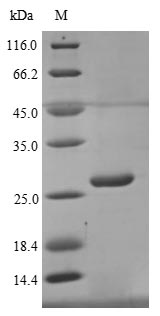Recombinant Human Butyrophilin subfamily 3 member A1 (BTN3A1) is expressed in a yeast system, spanning amino acids 30-254. This partial protein includes an N-terminal 6xHis-tag for simplified purification and detection. The product achieves a purity of over 90%, as confirmed by SDS-PAGE analysis, which appears suitable for research applications requiring high purity.
BTN3A1 is a protein that seems to modulate immune responses. Part of the butyrophilin family, it likely plays a role in cellular signaling pathways. Research suggests BTN3A1 interacts with immune cells, indicating its potential importance in studies of immune system regulation.
Potential Applications
Note: The applications listed below are based on what we know about this protein's biological functions, published research, and experience from experts in the field. However, we haven't fully tested all of these applications ourselves yet. We'd recommend running some preliminary tests first to make sure they work for your specific research goals.
Based on the provided information, recombinant human BTN3A1 is produced in a yeast expression system as a partial fragment (30-254aa) with an N-terminal 6xHis-tag. Yeast expression systems provide eukaryotic folding machinery, including chaperones and disulfide bond formation capabilities, which may support proper folding for this immunoglobulin-like protein. However, BTN3A1 is a complex transmembrane protein that typically requires full-length expression and proper membrane integration for complete bioactivity, particularly in γδ T cell activation. The partial nature of the fragment (lacking the transmembrane and cytoplasmic domains) may not fold independently as it would in the full-length protein context. Purity >90% by SDS-PAGE is determined under denaturing conditions and does not confirm native folding or bioactivity. No validation data (e.g., binding assays, circular dichroism) are provided. Therefore, while yeast expression increases the probability of correct folding compared to prokaryotic systems, the protein's folding status and bioactivity cannot be confirmed without experimental validation.
1. Antibody Development and Validation Studies
This recombinant BTN3A1 fragment can be used as an immunogen for antibody generation, as antibody development primarily relies on linear epitope recognition, which is independent of folding status. The high purity and defined sequence support consistent immunization results. However, if correctly folded, antibodies may recognize conformational epitopes relevant to native BTN3A1; if misfolded, generated antibodies might not optimally bind the full-length protein in biological contexts, limiting utility for functional studies.
2. Protein-Protein Interaction Studies
If the BTN3A1 fragment is correctly folded, the His-tag enables pull-down assays to identify binding partners, as proper folding is essential for biologically relevant interactions. However, if misfolded, interaction domains may be altered, leading to non-specific binding or failure to recognize genuine partners, compromising the validity of identified networks.
3. Structural and Biochemical Characterization
If properly folded, the fragment is suitable for biophysical studies like circular dichroism or dynamic light scattering to analyze domain-specific properties. However, if misfolded, structural data would misrepresent the native protein's architecture, and the partial nature limits insights into full-length BTN3A1 behavior.
4. Cell-Based Binding and Localization Studies
If correctly folded, the recombinant fragment could be used as a probe for cell surface binding studies, but if misfolded, it may exhibit non-specific binding or fail to recognize true receptors, leading to artifactual localization results. The lack of a transmembrane domain further reduces physiological relevance.
Final Recommendation & Action Plan
Before employing this recombinant BTN3A1 fragment in any application, it is essential to validate its folding and bioactivity through biophysical methods (e.g., circular dichroism for secondary structure, size-exclusion chromatography for oligomeric state) and functional assays (e.g., binding studies with known partners like Vγ9Vδ2 T cells or phosphoantigens); if validation confirms proper folding, proceed with applications while noting the limitations of the partial fragment; if misfolded, consider using full-length BTN3A1 expressed in mammalian systems for better physiological relevance or obtain a commercially validated standard; for immediate use, antibody development can proceed with the understanding that antibodies may require additional validation against native protein.






